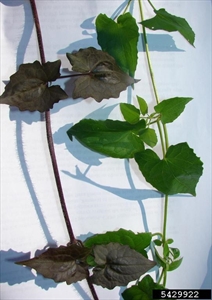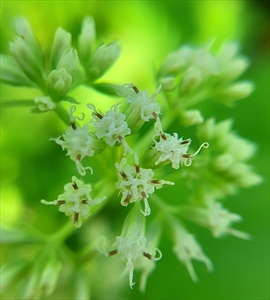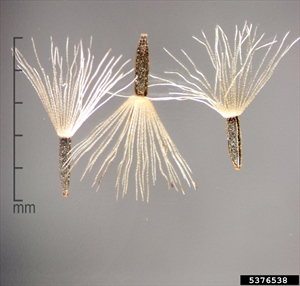- Widespread. Asia, Africa. North, South, Central America, Caribbean, Oceania. In most Pacific islands.
- Fast-growing, branched, long-lived, climbing vine (up to 25 m); smothering plantations (coconut, forestry, oil palm, cocoa), vegetable crops (taro), and native species, producing much seed; regrowing from stem cuttings. Thrives in open, sunny, disturbed situations, but tolerates partial shade. Produces chemicals inhibiting growth of competitors.
- Stems, up to 6 m, slender, ribbed lengthwise, few or no hairs, producing roots from stem-leaf junction. Leaves smooth, heart-shaped, shallow to toothed margins, up to 13 cm long, with stalks opposite along stem. Flowerheads, white or greenish-white, flat-topped clusters; flowers, 3-5 mm long, with protruding stamens. Seeds, black, thin, flattened, with fine, whitish bristles.
- Spread: vegetative propagation of stem pieces; seeds, by wind, animals, machinery, floodwater; intentionally as ground cover or soil conservation.
- Biosecurity: high risk of introduction; in Australia, 'restricted invasive plants': do not release into environment, give away or sell. Among 100 of World's Worst Invasive Alien Species (IUCN, 2020).
- Biocontrol: Rust, Puccinia spegazzinii, introduced into PNG, Fiji, Solomon Islands, Vanuatu. Psyllid, Heteropsylla spinulosa, released in Fiji, PNG, Samoa.
- Cultural control: hand weed, hoe or slash (but regrowth possible); plough; livestock (sheep, cattle) grazing; vehicle hygiene.
- Chemical control: in Australia: fluroxypyr; glyphosate; metsulfuron-methyl. Elsewhere, 2,4-D. In Fiji, glyphosate.









